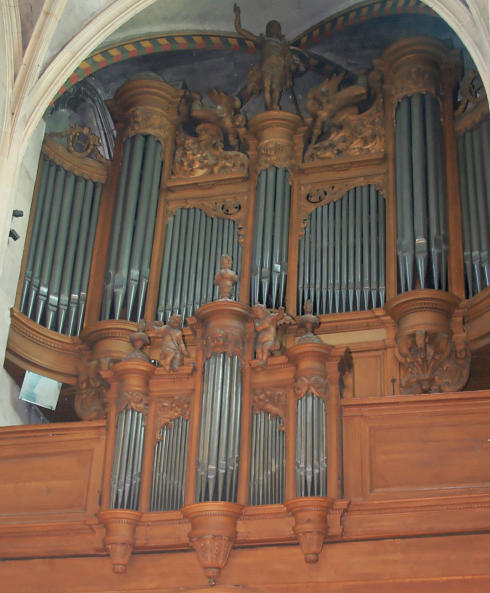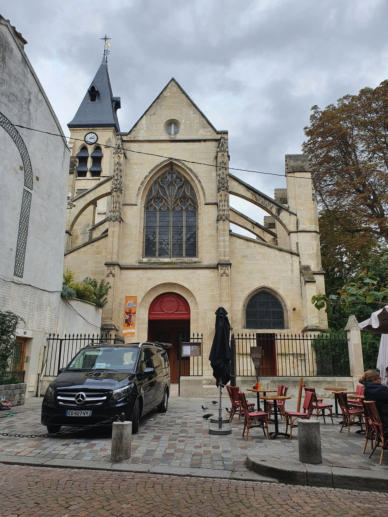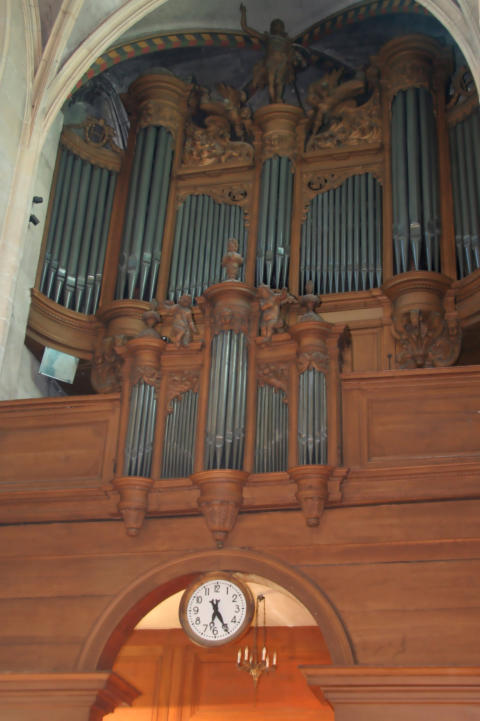


ORGANS OF PARIS © 2024 Vincent Hildebrandt HOME ALL ORGANS



This church was rebuilt in the second half of the
15th century in flamboyant gothic style at the
place of a former church of the 11 th century. It
was modified several times until the 18th
century, and has thus a rather heterogenic
appearance. Situated at the end of the medieval
and pittoresk Rue Mouffetard, this church is one
of the typical 'countryside' churches of Paris (as
is St. Germain de Charonne).

C2
This organ has a case sculpted around 1645 by Germain Pilon,
which initially housed an instrumental part placed in 1648 by
Jean et François de Héman. The organ has 27 stops spread
over 3 manuals and a pedalboard.
The case has been remodelled several times over the ages, in
particular by the addition of concave wings around its central
part. It successively housed a Cliquot organ (in the 18th
century) and then a Stoltz organ (in the 19th century).
Between 1648 and 1764, the organ was regularly enlarged
with the installation of Pleins Jeux, a tierce in the GO and the
Positif. In the first half of the eighteenth century, a half Récit
was added with a Cornet Vrgs and an 8' Trumpet.
1767
François-Henri Clicquot completely rebuilt the old instrument,
of which he kept only the case and the wooden pipes. Two
large concave wings were added on either side of the large
body of the case. The new organ consists of 33 stops spread
over 4 manuals and a pedalboard.
1778
Refurbishment of the wind tunnel by Adrien Lépine.
1829/1855
Overhauls by Pierre François Dallery and Thibaut.
1880
The instrumental part is once again completely redone by the
Stoltz brothers. The console was then turned upside down in
front of the nave and installed in the case of the back positive,
emptied of its pipes. Installation of a Barker machine in the
GO.
The console has three manual manuals: large organ, 10 stops;
positive, 10 stops; Récit expressive , 8 stops, and a 4-stop
pedalboard. Only five old stops have been preserved. The 4'
Montre on the façade of the Positif dates from the brothers
Jean and François de Héman (1645-1650), now silent.
1934
Gutschenritter carried out a restoration of the organ. On this
occasion, the Clairon 4' of the Positif was replaced by a Nazard
2 2/3'.
1978
Gutschenritter-Masset carries out a thorough cleaning of the
instrument. Reinstatement of the 4' Clairon of the Positif and
installation of a 4' Clairon in the GO.
1990/2001
Overhaul of the instrument by Bernard Dargassies.
Restoration of the Barker machine. Another overhaul was
performed in 2001.

1648 - Jean et François De Héman (1)
1767 - François-Henri Clicquot (3a)
1778 - Adrien Lepine (6)
1829 - Pierre-François Dallery (6)
1855 - Thibaut (6)
1880 - Stolz (3)
1934 - Gutschenritter (6)
1978 - Gutschenritter-Masset (6)
1990 - Dargassies (6)
2001 - Dargassies (6)
III/32 - traction mécanique
composition
Organiste titulaire
Jean Galard
Concerts
Seldom
Masses with organ
Saturday 6.30 PM Sunday 11 AM
Vidéos
Jean Galard
All organs built before the revolution
Photo: Jeroen de Haan
The organs of Paris

ORGANS OF PARIS © 2024 Vincent Hildebrandt ALL ORGANS
C2
This organ has a case sculpted around 1645 by Germain
Pilon, which initially housed an instrumental part placed in
1648 by Jean et François de Héman. The organ has 27 stops
spread over 3 manuals and a pedalboard.
The case has been remodelled several times over the ages,
in particular by the addition of concave wings around its
central part. It successively housed a Cliquot organ (in the
18th century) and then a Stoltz organ (in the 19th century).
Between 1648 and 1764, the organ was regularly enlarged
with the installation of Pleins Jeux, a tierce in the GO and
the Positif. In the first half of the eighteenth century, a half
Récit was added with a Cornet Vrgs and an 8' Trumpet.
1767
François-Henri Clicquot completely rebuilt the old
instrument, of which he kept only the case and the wooden
pipes. Two large concave wings were added on either side
of the large body of the case. The new organ consists of 33
stops spread over 4 manuals and a pedalboard.
1778
Refurbishment of the wind tunnel by Adrien Lépine.
1829/1855
Overhauls by Pierre François Dallery and Thibaut.
1880
The instrumental part is once again completely redone by
the Stoltz brothers. The console was then turned upside
down in front of the nave and installed in the case of the
back positive, emptied of its pipes. Installation of a Barker
machine in the GO.
The console has three manual manuals: large organ, 10
stops; positive, 10 stops; Récit expressive , 8 stops, and a 4-
stop pedalboard. Only five old stops have been preserved.
The 4' Montre on the façade of the Positif dates from the
brothers Jean and François de Héman (1645-1650), now
silent.
1934
Gutschenritter carried out a restoration of the organ. On
this occasion, the Clairon 4' of the Positif was replaced by a
Nazard 2 2/3'.
1978
Gutschenritter-Masset carries out a thorough cleaning of
the instrument. Reinstatement of the 4' Clairon of the
Positif and installation of a 4' Clairon in the GO.
1990/2001
Overhaul of the instrument by Bernard Dargassies.
Restoration of the Barker machine. Another overhaul was
performed in 2001.
1648 - Jean et François De Héman (1)
1767 - François-Henri Clicquot (3a)
1778 - Adrien Lepine (6)
1829 - Pierre-François Dallery (6)
1855 - Thibaut (6)
1880 - Stolz (3)
1934 - Gutschenritter (6)
1978 - Gutschenritter-Masset (6)
1990 - Dargassies (6)
2001 - Dargassies (6)
III/32 - traction mécanique
composition
Organiste titulaire
Jean Galard
Concerts
Seldom
Masses with organ
Saturday 6.30 PM Sunday 11 AM
Vidéos
Jean Galard
All organs built before the revolution
Photo: Jeroen de Haan






















